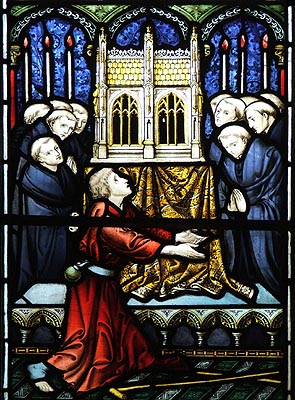
EBK Home
Kingdoms
Royalty
Saints
Pedigrees
Archaeology
King Arthur
Mail David
 Shrines of
Shrines ofSt. Edburga
Pious Princess divided in Two
Upon the death of this Royal nun, in AD 960, at the Nunnaminster in Winchester (Hampshire), she was buried in a simple grave within the walls of the Abbey Church. However, the sisters found that they were unable to close a window overlooking her grave and they became convinced of her sanctity. Miracles were reported at her tomb and Abbess Alfghena called upon Bishop Aethelwold to help in the removal of her body to a costly new shrine before the high altar. This was later refurbished, by Abbess Alfflaed, who covered the feretory in "precious metals and decorated [it] with topaz".
Edburga's original burial site may have been in a not so humble tomb in a southern apse at the west end of the old Saxon Nunnaminster. A prominent mid-10th century rectangular masonry recess, built to receive a body, was excavated in this position in the early 1980s. The grave had been destroyed during the church's rebuilding in AD 964, by which time all human remains had already been carefully removed. There are clear parallels with St. Swithun's post-mortem movements at the nearby Old Minster at a very similar date.
Though St. Edburga's Shrine survived for several centuries at the Nunnaminster (and the subsequent St. Mary's Abbey), by the mid 970s, Bishop Aethelwold had agreed to translate a major portion of her relics to the newly refounded Abbey at Pershore in Worcestershire. The circumstances are unclear, but he apparently persuaded the nuns of Nunnaminster to part with their most holy of possessions on behalf of Pershore's patron, Earl Aegelward of Dorset, possibly in return for some kind of payment. Her name was reverred there even after the Norman Conquest when the memory of so many Saxon saints were suppressed.
At Pershore, the lady was eventually enshrined in St. Edburga's Chapel. Originally in the south transept, this was greatly extended eastwards, around 1300, in order to accommodate the vast numbers of pilgrims visiting her remains. Both shrines finally disappeared during the Dissolution of the Monasteries in the early 16th century.
